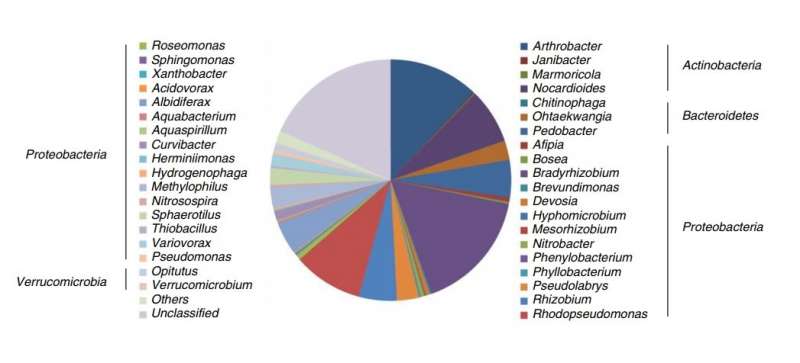October 3, 2017 feature
Plant-consuming microorganisms produce low-carbon, renewable natural gas

(Phys.org)—A new study shows that plant-consuming microorganisms that reside in coalbeds can convert plant carbohydrates into natural gas, potentially offering a sustainable, clean method of energy generation.
For more than a century, coalbeds have not only been a source of coal, but of natural gas as well. Until recently, it was thought that the natural gas in coalbeds formed millions of years ago, at the same time the coal itself was being formed. In recent years, however, scientists have discovered that there are microorganisms that currently live in coalbeds that feed on the hydrocarbons in the coal, and in doing so convert the coal into natural gas.
Unfortunately, once the natural gas from coalbeds begins to be pumped from the wells, it becomes rapidly depleted within a few years. Research has shown that this depletion occurs because the microorganisms run out of bioavailable carbon content from the coal—essentially, they have nothing left to eat. While there have been several attempts to biostimulate the microorganisms with additional nutrients, in the end the microorganisms still require bioavailable carbon from the coal to continue producing natural gas.
Now in a new study published in Nature Communications, researchers Zaixing Huang et al., from the University of Wyoming and Taiyuan University of Technology, have investigated whether the microorganisms living in coalbeds might expand their appetite to consume plant-derived carbohydrates in addition to coal.
The researchers found that, when their diets were supplemented with carbohydrates from crops such as alfalfa, switch grass, miscanthus, and sugar beet, the microorganisms increased the production of natural gas. This is the first time it has been shown that microorganisms living in coalbeds can convert something other than coal into natural gas.
"The greatest significance of the research is to show that renewable natural gas can be produced within geological formations with unprecedented scalability and meanwhile reduce the concentration of atmospheric carbon dioxide," Huang told Phys.org. "There is the possibility to reduce the extent of heavy reliance on fossil fuels as primary energy and hence the opportunity of mitigating global warming."
As the researchers explain, the new process not only has the potential to increase the overall production rate of natural gas from coalbeds, but also to do so in a carbon-neutral or even carbon-negative way—that is, the process may take in more carbon than it releases. When the microorganisms use coal as a food source, the natural gas produced from the coal is considered carbon-positive, as the coal had been sequestered in the earth for millions of years.
On the other hand, when the microorganisms use plants as a food source, the natural gas is considered carbon-neutral because the plants have only captured and fixed the carbon dioxide in the atmosphere into plant biomass (via photosynthesis) very recently. Further, some of the carbon injected into the coal seams is in the form of carbon dioxide gas. Since coal's porous surface gives it a strong affinity for adsorbing gases, the coalbeds effectively serve as a carbon capture and storage facility. In this case, the process may become carbon-negative.
Overall, the researchers expect that using plant-derived carbohydrates as an alternative carbon source to coal may offer a cleaner fuel than fossil fuels—both coal and the currently produced form of natural gas. With carbon credits, the process could also be economically viable, which may help bridge the gap between fossil fuels and renewable energy sources.
In the future, the researchers plan to demonstrate the new method in test sites around the world.
"The next step is to focus on field demonstration projects to evaluate the applicability of the technology in coalbeds," Huang said. "The ultimate goal is to fully develop the technology so that it can be used universally, including for other geological formations. I hope the technology can be implemented and help developing countries in acquiring this affordable, clean renewable energy in the long run. Several sites (USA and Asia) have been selected as candidates for field demonstration. Preliminary studies and characterizations of these sites have started."
More information: Zaixing Huang et al. "Low carbon renewable natural gas production from coalbeds and implications for carbon capture and storage." Nature Communications. DOI: 10.1038/s41467-017-00611-7
Journal information: Nature Communications
© 2017 Phys.org


















